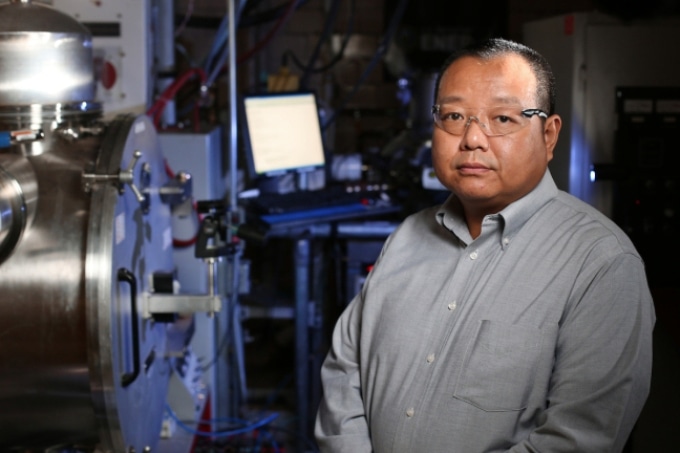Sep 29 2016
 Jun Cui works with a metal spinner, which rapidly solidifies metal into thin ribbons, and other equipment in his lab. (Photo by Christopher Gannon)
Jun Cui works with a metal spinner, which rapidly solidifies metal into thin ribbons, and other equipment in his lab. (Photo by Christopher Gannon)
The U.S. Department of Energy (DOE) aims to make plug-in electric vehicles as economical and convenient as the internal-combustion vehicles currently in use. However, this goal is yet to be achieved.
The EV (plug-in electric vehicles) Everywhere initiative was introduced in 2012 by President Obama and the DOE. The DOE had stipulated that electric vehicles should become 30% lighter, battery costs should reduce from $500 per kilowatt hour to $125 per kilowatt hour, and electric drive systems should decrease from $30 per kilowatt to $8 per kilowatt.
“Typically, in the engineering world, when you have a problem like this, you look at the system, for example the motor design,” said Jun Cui, an Iowa State University associate professor of materials science and engineering and a senior scientist with the DOE’s Ames Laboratory.
But electric motors have been in existence since the 1830s. The simple system solutions were discovered a long time ago.
The hard stuff is material-related. It’s the demand for better materials.
Jun Cui, Associate Professor, Iowa State University
A New Vehicle Technologies Grant
Cui heads a research team that is involved in meeting the demand for performance in electric motors and for better materials. A three-year $3.8 million grant from the DOE’s Vehicle Technologies Program was given to support the team’s endeavors. About $2.8 million of the grant will support research activities at Iowa State.
The project also includes research collaborators from the University of Delaware in Newark; and the United Technologies Research Center in East Hartford, Connecticut.
Cui said the project became a reality because of a combination of the research expertise and facilities of Iowa State and the Ames Laboratory.
Local collaborators include Scott Chumbley, a professor of materials science and engineering and scientist for the Ames Laboratory; Peter Collins, the Alan and Julie Renken associate professor of materials science and engineering and an associate scientist of the Ames Laboratory; Iver Anderson, a senior metallurgist for the Ames Laboratory and an adjunct professor of materials science and engineering; Valery Levitas, a Schafer 2050 Challenge Professor of aerospace engineering and an associate scientist of the Ames Laboratory; Frank Peters, an associate professor and associate chair of operations in industrial and manufacturing systems engineering; and Matthew Kramer, director of the Ames Laboratory’s Division of Materials Sciences and Engineering and an adjunct professor of materials science and engineering.
Cui said the modeling and fundamental experimental efforts of the project will be based at Iowa State while the large-scale casting and part molding aspects of the project will be based at the Ames Laboratory. Cui added that the grant may not have come through without his previous steel research at the DOE’s Pacific Northwest National Laboratory in Richland, Washington.
This is truly a collaboration. It’s not all Ames Laboratory or Iowa State, but people from both joining together to make this project happen.
Jun Cui, Associate Professor, Iowa State University
The grant forms a part of a $59.2 million federal investment in 35 research projects aimed at decreasing the cost and enhancing the efficiency of conventional, electric, and alternative-fuel vehicles, according to an announcement by the DOE.
‘Electrical steel’
Cui’s research team aims to develop motors with the stator core, which is a non-rotating, magnetic component manufactured with thin layers, or laminations, of a new “electrical steel.” The new steel will be an iron alloy with 6.5% silicon, double the quantity used in present electric motors.
Cui said the additional silicon boosts the electrical resistivity of the material by approximately 50%. It also decreases eddy currents, power loss, and heat in the motor. These factors are vital as researchers strive to build the next generation of electric motors. Cui envisions that those motors could operate at much higher frequencies – from the current 60 hertz up to 400 hertz.
Cui said that the higher frequencies will help to produce a much higher motor power density. This would mean motors can be lighter, smaller, more cost effective, and more powerful.
Operating at higher frequencies reduces motor efficiency. The new electrical steel being developed by Cui’s team would be capable of reducing those efficiency losses. However, there is a hitch: Steel with more silicon tends to become brittle and is expensive to manufacture.
“It will crack if you drop it,” Cui said.
The Iowa State-Ames Laboratory team will analyze and characterize various processes to make electrical steel so it is highly pliable and economical to manufacture.
Cui explained that his team is also focused on creating materials and motors that do not rely on magnets produced using rare-earth materials. This would save the motor industry the growing costs of rare-earth materials.
The fundamental drive for this project is that we want more cost-effective and efficient electric motors. In about 10 years, if we’re lucky, we should see a real impact of this work. We should see these motors on the road.
Jun Cui, Associate Professor, Iowa State University